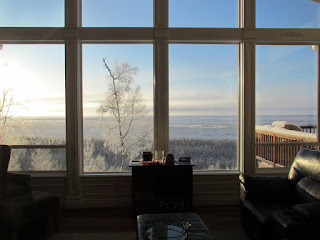
We trekked across the hay flats a couple of weeks ago, before the snow got deep. About 3 miles from the house we reached the frozen Matanuska River. In the Summer, this bank is mud and marsh, and very difficult to reach. In the past there have been seals who pulled out of the water onto the banks and occasionally they venture into the hay flats. Other long-time locals have told us about beluga whales who chase salmon this far up the river from Cook Inlet, but we haven't seen any belugas anywhere other than the Inlet and Turnagain Arm south of Anchorage - though at high tide they would have enough water to make it this far.

Walking to the River provides some fantastic views from out on the hay flats.

Dino enjoyed the limit-free chance to roam.


Muskrats live in the marshy areas of the flats, and build large dens called lodges to stay in during the winter. Their habit of collecting plant stalks and roots to build their lodge creates large open water areas. Our first few years here we had a muskrat population explosion, and large areas of the hay flats became open water. At the time I thought the flats were flooding due to sea level rise, but it turned out to be the work of busy muskrats, pulling clumps of grass up to build numerous lodges. Since then the muskrat population has seemingly stabilized.


This old tree stump looks like a whale's tail breaking the surface of the ocean. Several large tree stumps and trunks are still present on the flats. Before the Good Friday Earthquake of 1964 there were clumps of trees on the flats and much of the flats were cultivated for hay. During that 9.2 magnitude earthquake, these flats subsided 15 feet, and became too wet to cultivate.

Frost collects on the plant tips, giving the appearance of cotton balls across the flats.

One of the ravines leading from the flats to the river.

The river has a very large tidal range, and can vary nearly 20 feet in water level due solely to tidal fluctuations. These tidal fluctuations lift great blocks of ice and mud up onto the banks at high tide.

The muddy banks, frozen and lifted.

Like a sea of obstacles, these scattered ice blocks give the appearance of being on a different planet.

Approaching the river.


The frozen river at low tide shows the steep frozen bank, nearly 15 feet tall.

The river still runs beneath the ice, but in most places the ice is thick enough to support much weight.

We might be the only humans to visit this part of the river this winter, just one of the many places around this vast state that sees little if any human interaction.



Turning around, with the river at my back, here's a picture back towards our house. You can just make out the house in the tree cutout above the snowy river bank.

Another remnant of the the trees that once stood here 54 years ago, before the earthquake.

The boys enjoyed the walk and views of the frozen river.


The pretended they were exploring the surface of a planet no other human had visited - - which doesn't take too much imagination in a unique landscape like this.

Back at the house, two moose are visible out on the flats above Landon's shoulder as he downs a bowl of cereal in the breakfast nook.

Everyday the creation around us seems to change a little, and provide a new opportunity to explore. In the 10 years since we first moved here, we had never walked all the way to the river. Will need to find a way to venture there in the Summer when it is thawed, to see what wildlife we can find.
Videos below taken on our walk.

No comments:
Post a Comment